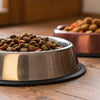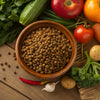Should You Moisten Dry Dog Food? Exploring the Benefits and Drawbacks
- Houndsy
Table of Contents
- Introduction
- The Benefits of Moistened Dry Dog Food
- The Drawbacks of Moistened Dry Dog Food
- Tips for Adding Water to Dry Dog Food
- Conclusion
Introduction
As devoted pet owners, we constantly strive to provide the best for our furry companions. One question that often arises in the realm of pet nutrition is, should you moisten dry dog food? A significant number of dog owners are curious about the implications of this practice, especially considering the increasing variety of pet food options available today. In fact, studies suggest that nearly 40% of pet owners have considered modifying their pets' food texture for various reasons, from enhancing palatability to aiding digestion.
Understanding whether to add water to dry kibble can be crucial for our pets' health and well-being. By moistening dry dog food, we might improve hydration, increase palatability, and make mealtime more enjoyable. However, there are also potential downsides, including spoilage and changes in the food's texture that could affect dental health.
In this blog post, we'll explore the advantages and disadvantages of moistening dry dog food, addressing common concerns and misconceptions. We aim to help you make an informed decision about your dog's feeding routine while considering their unique needs and preferences. So, let’s dive deeper into the topic and see how moistening kibble may affect your dog’s overall health and happiness.
The Benefits of Moistened Dry Dog Food
Enhanced Palatability
One of the most compelling reasons to consider adding water to dry dog food is to enhance its flavor and aroma. Just like humans enjoy a warm, hearty stew, dogs can find moistened kibble much more appealing. When we add water, we release the enticing scents and flavors locked within the kibble, making it more appetizing.
For picky eaters or dogs recovering from illness, this simple adjustment can make a significant difference. By transforming dry kibble into a palatable meal, we can encourage our furry friends to eat more consistently. This is particularly beneficial for dogs that may have lost their appetite due to stress or health issues.
Improved Hydration
Hydration is essential for maintaining our pets' health, yet not all dogs drink enough water. By moistening their kibble, we provide an additional source of hydration, which can be particularly beneficial during hot weather or after vigorous exercise. Moist kibble can help ensure that your furry friend gets the fluids they need, promoting overall health and well-being.
For dogs that are reluctant to drink, soaking their kibble can be a stealthy way to sneak in those extra fluids. This method can be especially advantageous for breeds that are prone to dehydration, helping them maintain optimal hydration levels without the need for constant monitoring.
Easier to Chew and Digest
Moistening dry dog food can make it easier for dogs to chew and digest, particularly for older pets or those with dental issues. By softening the kibble, we reduce the strain on their teeth and gums, allowing them to enjoy their meals without discomfort. This is especially crucial for senior dogs or those with missing teeth, as hard kibble can be challenging to eat.
Additionally, softened kibble can be gentler on the digestive system, making it easier for dogs to break down their food. This can help reduce the risk of digestive upset, particularly in older dogs or those with sensitive stomachs. By providing an easily digestible meal, we can promote better nutrient absorption and overall health.
Slower Eating and Reduced Choking Risk
For dogs that tend to gulp their food, moistening kibble can help slow down their eating pace. When kibble is soaked, it becomes less likely for dogs to inhale their food whole, reducing the risk of choking. This is especially important for breeds that are prone to bloat, a potentially life-threatening condition that can occur when a dog eats too quickly.
By making mealtimes more manageable, we can help our pets enjoy their food without the associated risks. This simple adjustment can lead to a more relaxed eating experience, contributing to better digestion and overall health.
The Drawbacks of Moistened Dry Dog Food
Potential for Spoilage
One of the primary concerns with adding water to dry dog food is the risk of spoilage. When moist food is left out for too long, it can create an environment conducive to bacterial growth, which can lead to gastrointestinal issues. In warmer climates, this risk is even more significant, as bacteria thrive in higher temperatures.
To mitigate this risk, it's crucial to serve the moistened kibble immediately and discard any uneaten portions after a short period, typically within an hour. This practice helps ensure that your dog consumes fresh food while minimizing the risk of foodborne illness.
Loss of Nutritional Value
Another consideration when adding water to dry dog food is the potential dilution of nutrients. Soaking kibble for an extended period may cause certain vitamins and minerals to leach into the water, reducing the overall nutritional value of the meal. While this loss may not be significant, it can accumulate over time, particularly if the soaked kibble becomes a regular part of your dog's diet.
It's essential to be mindful of this factor, especially if your dog relies on kibble as their primary source of nutrition. If you decide to moisten their food, consider consulting with a veterinarian or pet nutritionist to ensure that their dietary needs are still being met.
Dental Health Considerations
While moistening kibble can be beneficial for dogs with dental problems, it may also negatively impact dental health for others. Dry kibble's abrasive texture can help scrape away plaque and tartar as dogs chew, promoting oral health. When kibble is soaked, it loses this crunchy texture, potentially leading to an increase in plaque buildup.
If dental health is a concern for your dog, consider balancing moistening their food with regular dental care practices, such as brushing their teeth or providing dental chews. Maintaining a comprehensive dental hygiene routine can help ensure your dog’s teeth and gums remain healthy, even if you choose to moisten their kibble.
Changes in Feeding Routine
Moistening dry dog food can also alter your dog's feeding routine. Some pets may take longer to eat wet kibble compared to dry, which can be an adjustment for both the pet and the owner. Additionally, dogs that are accustomed to dry kibble might initially reject the change in texture, requiring patience and monitoring.
To ease the transition, we can introduce moistened kibble gradually, mixing it with their regular dry food until they adapt to the new texture. This method helps ensure a smooth transition while allowing us to assess how our dog responds to the changes.
Tips for Adding Water to Dry Dog Food
If you decide to moisten your dog's kibble, here are some practical tips to ensure the process is safe and effective:
- Use Warm Water: Warm water can enhance the aroma and flavor of the kibble, making it more appealing to your dog. Avoid using hot water, as it could potentially burn your pet's mouth.
- Soak for a Short Time: Allow the kibble to soak for about 10-15 minutes, just long enough to soften it without risking spoilage. This timeframe helps preserve the nutritional content while still providing the benefits of moist food.
- Serve Immediately: Always serve moistened kibble right after preparation. Discard any uneaten portions within an hour to prevent bacterial growth.
- Monitor Your Dog's Response: Pay attention to how your dog reacts to the moistened kibble. Watch for signs of digestive upset or changes in appetite, and adjust their feeding routine as needed.
- Consult Your Veterinarian: If you have concerns about your dog's diet or health, consult your veterinarian for personalized advice. They can provide guidance on whether moistening kibble is appropriate for your pet's individual needs.
Conclusion
Ultimately, the decision of whether to moisten dry dog food depends on your dog's specific needs and preferences. While there are numerous benefits, such as improved palatability and hydration, we must also consider the potential drawbacks, including spoilage and changes in dental health.
By carefully weighing the pros and cons, we can make informed choices that support our dog's health and happiness. If you find that moistening kibble enhances your dog's mealtime experience, it can be a simple yet effective way to improve their overall well-being.
If you're looking for an innovative solution to elevate your dog's feeding experience, we invite you to explore the Houndsy Kibble Dispenser. Our thoughtfully designed product not only ensures perfect portion control, but it also harmonizes with your home decor. By incorporating convenience and style, we're committed to simplifying your pet care routine while enhancing the daily feeding ritual.
FAQ
1. Is it safe to moisten dog food? Yes, it is safe to moisten dog food, but it’s essential to serve it immediately and discard any leftovers within an hour to prevent spoilage.
2. How long should I soak dry dog food? Soaking dry dog food for about 10-15 minutes in warm water is typically sufficient to soften it without risking spoilage.
3. Will moistening kibble affect my dog's dental health? Moistening kibble can potentially reduce its abrasive properties, which help with dental health. If dental health is a concern, consider maintaining a dental care routine alongside moistening their food.
4. Can all dogs benefit from moistening their food? While many dogs benefit from moistening their food, those with specific dietary needs or health concerns should be evaluated by a veterinarian to determine the best feeding approach.
5. Should I consult a veterinarian before changing my dog's diet? Yes, it's always a good idea to consult your veterinarian before making significant changes to your dog's diet to ensure their nutritional needs are met.












